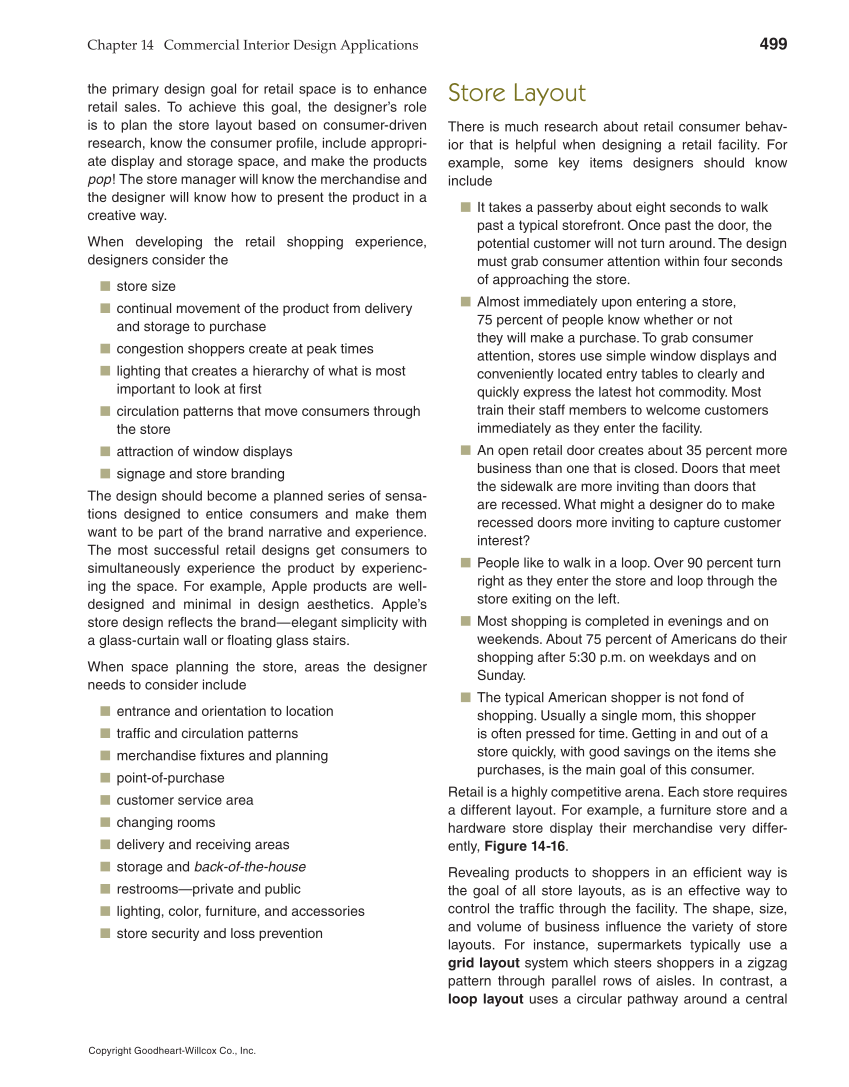Chapter 14 Commercial Interior Design Applications 499 Copyright Goodheart-Willcox Co., Inc. the primary design goal for retail space is to enhance retail sales. To achieve this goal, the designer’s role is to plan the store layout based on consumer-driven research, know the consumer profi le, include appropri- ate display and storage space, and make the products pop! The store manager will know the merchandise and the designer will know how to present the product in a creative way. When developing the retail shopping experience, designers consider the ■ store size ■ continual movement of the product from delivery and storage to purchase ■ congestion shoppers create at peak times ■ lighting that creates a hierarchy of what is most important to look at fi rst ■ circulation patterns that move consumers through the store ■ attraction of window displays ■ signage and store branding The design should become a planned series of sensa- tions designed to entice consumers and make them want to be part of the brand narrative and experience. The most successful retail designs get consumers to simultaneously experience the product by experienc- ing the space. For example, Apple products are well- designed and minimal in design aesthetics. Apple’s store design refl ects the brand—elegant simplicity with a glass-curtain wall or fl oating glass stairs. When space planning the store, areas the designer needs to consider include ■ entrance and orientation to location ■ traffi c and circulation patterns ■ merchandise fi xtures and planning ■ point-of-purchase ■ customer service area ■ changing rooms ■ delivery and receiving areas ■ storage and back-of-the-house ■ restrooms—private and public ■ lighting, color, furniture, and accessories ■ store security and loss prevention Store Layout There is much research about retail consumer behav- ior that is helpful when designing a retail facility. For example, some key items designers should know include ■ It takes a passerby about eight seconds to walk past a typical storefront. Once past the door, the potential customer will not turn around. The design must grab consumer attention within four seconds of approaching the store. ■ Almost immediately upon entering a store, 75 percent of people know whether or not they will make a purchase. To grab consumer attention, stores use simple window displays and conveniently located entry tables to clearly and quickly express the latest hot commodity. Most train their staff members to welcome customers immediately as they enter the facility. ■ An open retail door creates about 35 percent more business than one that is closed. Doors that meet the sidewalk are more inviting than doors that are recessed. What might a designer do to make recessed doors more inviting to capture customer interest? ■ People like to walk in a loop. Over 90 percent turn right as they enter the store and loop through the store exiting on the left. ■ Most shopping is completed in evenings and on weekends. About 75 percent of Americans do their shopping after 5:30 p.m. on weekdays and on Sunday. ■ The typical American shopper is not fond of shopping. Usually a single mom, this shopper is often pressed for time. Getting in and out of a store quickly, with good savings on the items she purchases, is the main goal of this consumer. Retail is a highly competitive arena. Each store requires a different layout. For example, a furniture store and a hardware store display their merchandise very differ- ently, Figure 14-16. Revealing products to shoppers in an effi cient way is the goal of all store layouts, as is an effective way to control the traffi c through the facility. The shape, size, and volume of business infl uence the variety of store layouts. For instance, supermarkets typically use a grid layout system which steers shoppers in a zigzag pattern through parallel rows of aisles. In contrast, a loop layout uses a circular pathway around a central
